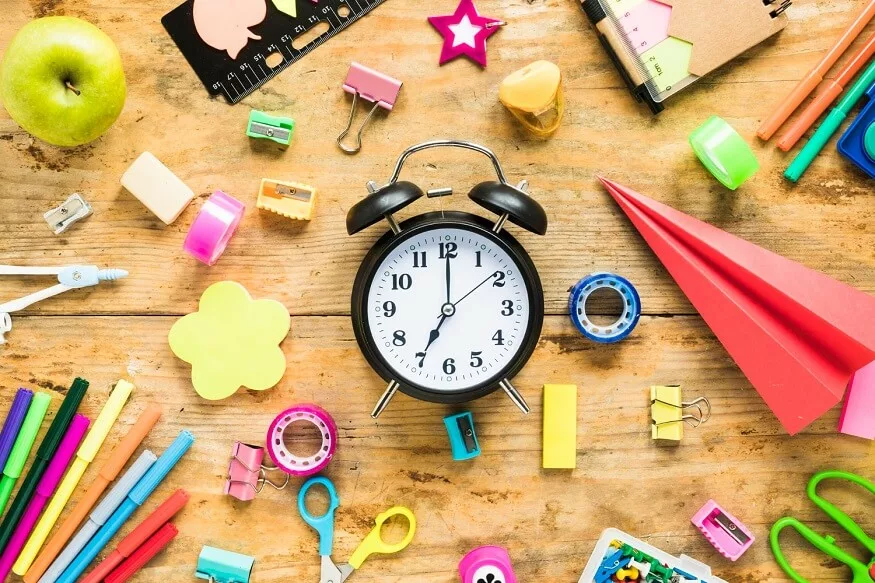As parents and educators, we understand the significance of imparting fundamental skills to our little ones, and one of these essential skills is learning to tell the time. Introducing clock activities for preschoolers is not only a fun and interactive way to educate them but also lays the foundation for a lifelong skill. In this article, we delve into the world of learning clock activities that are not only educational but also enjoyable for our young learners.
Learning clock activities
1. Crafting Your Own Clock
Creating a clock from scratch is a hands-on activity that not only introduces the basic structure of a clock but also enhances fine motor skills.
Materials Needed
- Paper plates
- Split pins
- Markers
- Craft sticks
Activity Steps
- Divide a paper plate into 12 sections and label each section with numbers 1 through 12.
- Attach craft sticks as clock hands with a split pin in the center.
- Decorate the clock with colours and designs.
- Engage the child in discussions about numbers and the concept of time.
2. Interactive Teaching Clock
Investing in an interactive teaching clock is a resourceful way to make learning about time an enjoyable experience.
Choosing the Right Clock
Opt for teaching clocks that are colourful, have large numbers, and use different colours for the hour and minute hands. Some also come with movable hands for interactive learning.
Activities
- Matching Time: Use the interactive clock to match the displayed time with objects or activities relevant to that time.
- Setting the Clock: Encourage the child to set the clock hands to specific times, reinforcing the association between clock faces and different times of the day.
Also Read: 8 Surprising Benefits of Hidden Object Games You Must Know
3. Clock Faces with Daily Activities
Associating specific times with daily activities helps preschoolers understand the practical application of time.
- Creating a Visual Schedule: Craft a visual schedule with pictures representing activities at different times (e.g., eating breakfast at 8, playing at 10). This connects the abstract concept of time to real-life events.
- Interactive Discussion: Engage in conversations about the sequence of events throughout the day, linking them to the corresponding times on the clock.
4. Telling Time with Storytelling
Storytelling is a powerful tool for introducing time-related concepts in a narrative form.
- Story Creation: Craft a simple story where characters engage in different activities at specific times. For example, “At 7 o’clock, the sun wakes up, and so does our little friend, Bunny.”
- Interactive Elements: Encourage the child to point to the clock or move the clock hands as the story progresses.
5. Clock Games
Transforming learning into a game adds an element of fun and excitement to understanding time.
- Time Bingo: Create a bingo card with different times written on it. Call out times randomly, and the child can mark the corresponding time on their card.
- Clock Face Matching: Prepare cards with different clock faces showing various times. Ask the child to match these cards to the correct times displayed on an interactive clock.
6. Outdoor Sundial Adventure
Take learning beyond the walls and introduce the concept of shadows and time with a simple sundial activity.
Materials Needed
- A stick
- Chalk
- Sunny day
Activity Steps:
- Plant the stick firmly in the ground.
- Throughout the day, mark the tip of the shadow cast by the stick with chalk.
- Discuss how the position of the shadow changes as the day progresses, relating it to different times
7. Musical Clock Play:
Transforming the clock into a musical instrument adds a creative and rhythmic element to learning time.
Crafting a Musical Clock:
- Attach bells or chimes to the numbers on a large clock face.
- Encourage the child to ring the bell corresponding to the hour you call out.
Benefits:
- Associating sounds with hours reinforces the connection between numbers and time.
Also Read: Exciting Calendar Games for Kindergarten That Will Delight Children
What Do Clock Activities Teach Preschoolers
1. Learn the Time Clock
The journey of learning the time clock begins with introducing the basic concept of hours and minutes. Utilise a colourful and interactive teaching clock to capture the attention of preschoolers. These visually appealing tools make learning the time an exciting adventure. Incorporate vibrant colours and clear numbering to make the experience both educational and visually stimulating.
2. Interactive Teaching Clock
Transforming the learning experience into a game is a proven method to capture the interest of preschoolers. An interactive teaching clock serves as a fantastic tool for this purpose. Consider using clock apps or online games that allow children to manipulate the clock hands, associating the numbers with the position of the hands. This hands-on approach not only reinforces their understanding but also turns the learning process into an enjoyable activity.
3. Clock Activities for Preschoolers
Engage preschoolers in a variety of clock activities designed to make time-telling a joyful experience. Incorporate crafts such as DIY clock-making, where children get to assemble their clocks using cardboard, markers, and clock hands. This not only reinforces their understanding of the clock structure but also enhances their fine motor skills.
4. Learning Clock Activities
Combine storytelling with learning clock activities to make the experience more immersive. Craft stories where characters embark on adventures that involve specific times of the day. Encourage children to adjust the clock hands as the story progresses, actively involving them in the narrative while reinforcing time-telling skills.
5. Teaching Clock Game
Introduce a teaching clock game to make the learning process competitive and exciting. Games like “Clock Bingo” or “Tick-Tock Race” can make learning the time a group activity. By adding an element of competition, you not only enhance their time-telling abilities but also foster a sense of camaraderie among the preschoolers.
Also Read: Daily New Words for Kids: Basic & Simple Golden Words
Incorporating these clock activities for preschoolers into your teaching repertoire can significantly contribute to the development of time-telling skills. Remember, the key is to make learning the time an enjoyable journey, blending education with entertainment. As children enthusiastically participate in interactive teaching clock activities, they are not just learning to tell the time; they are embarking on a path to appreciate the value of time itself. Whether crafting a clock, playing games, or venturing outdoors, EuroSchool conducts each activity and adds a layer of understanding to the concept of time.










